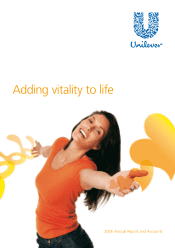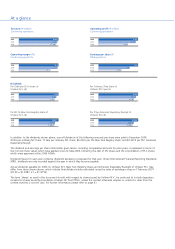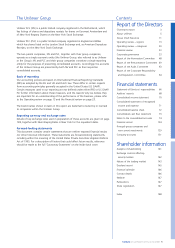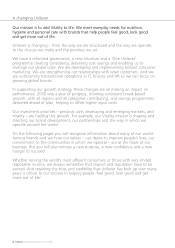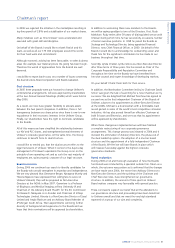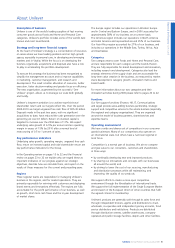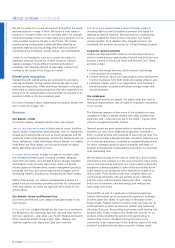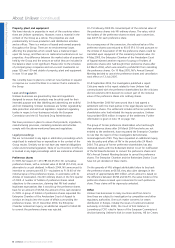Unilever 2006 Annual Report Download - page 11
Download and view the complete annual report
Please find page 11 of the 2006 Unilever annual report below. You can navigate through the pages in the report by either clicking on the pages listed below, or by using the keyword search tool below to find specific information within the annual report.
8Unilever Annual Report and Accounts 2006
Report of the Directors (continued)
About Unilever (continued)
Property, plant and equipment
We have interests in properties in most of the countries where
there are Unilever operations. However, none is material in the
context of the Group as a whole. The properties are used
predominantly to house production and distribution activities
and as offices. There is a mixture of leased and owned property
throughout the Group. There are no environmental issues
affecting the properties which would have a material impact
upon the Group, and there are no material encumbrances on our
properties. Any difference between the market value of properties
held by the Group and the amount at which they are included in
the balance sheet is not significant. Please refer to the schedule
of principal group companies and non-current investments on
page 129 and 130 and details of property, plant and equipment
in note 10 on page 90.
We currently have no plans to construct new facilities or expand
or improve our current facilities in a manner that is material to
the Group.
Laws and regulation
Unilever businesses are governed by laws and regulations
designed to ensure that products may be safely used for their
intended purpose and that labelling and advertising aretruthful
and not misleading. Unilever businesses are further regulated by
data protection and anti-trust legislation. Important regulatory
bodies in respect of our businesses include the European
Commission and the US Food and Drug Administration.
Wehave processes in place to ensure that products, ingredients,
manufacturing processes, marketing materials and activities
comply with the above-mentioned laws and regulations.
Legal proceedings
Weare not involved in any legal or arbitration proceedings which
might lead to material loss or expenditure in the context of the
Group results. Similarly we do not have any material obligations
under environmental legislation. None of our Directors or Officers
is involved in any legal proceedings which are material as aforesaid.
Preference shares
In 1999, NV issued 211 473 785 €0.05 (Fl.0.10) cumulative
preference shares, with a notional value of €6.58 (Fl.14.50), as an
alternative to a cash dividend. In March 2004, NV announced its
intention to convert part (€6.53 – equivalent to Fl.14.40) of the
notional value of the preference shares, in accordance with its
Articles of Association, into NV ordinary shares in the first quarter
of 2005. A number of holders of preference shares raised
objections to the conversion, claiming that NV had created
legitimate expectations that it would buy the preference shares
back for an amount of €6.58, the amount of the cash dividend
in 1999. A group of holders of preference shares requested the
Enterprise Chamber of the Amsterdam Court of Appeal to
conduct an inquiry into the course of affairs surrounding the
preference shares. On 21 December 2004, the Enterprise
Chamber ordered an inquiry; an additional request to forbid NV
to convert the preference shares was rejected.
On 15 February 2005 NV converted part of the notional value of
the preference shares into NV ordinary shares. The value, which
the holders of the preference shares received upon conversion,
was €4.55 for each preference share.
As a consequence of the conversion, the notional value of the
preference shares was reduced to €0.05 (Fl.0.10) and pursuant to
the Articles of Association of NV the preference shares could be
cancelled upon repayment of this remaining notional value. On
4May 2005, the Enterprise Chamber of the Amsterdam Court
of Appeal rejected another request of a group of holders of
preference shares who had bought their preference shares after
24 March 2004, which was aimed to prohibit NV from cancelling
the preference shares. On 10 May 2005, NV’s Annual General
Meeting decided to cancel the preference shares and cancellation
took effect on 13 July 2005.
On 8 September 2006, the investigators published a report.
Criticisms made in this report related to how Unilever had
communicated with the preference shareholders but the criticisms
did not extend to NV’s decision to convert part of the notional
value of the preference shares into ordinary shares.
On 8 November 2006 NV announced that it had agreed a
settlement with the main parties in the legal dispute over the
preference shares. The settlement includes all former preference
shareholders who had initiated the inquiry procedure. Unilever
has provided €300 million in respect of the settlement. Further
information is given in note 19 on page 102.
The group of former preference shareholders who had bought
their preference shares after 24 March 2004 and who are not
entitled to the settlement, have requested the Enterprise Chamber
to rule that the report of the investigators demonstrates
mismanagement of NV. They have requested an additional inquiry
into the policy and affairs of NV in the period after 24 March
2004. This group of former preference shareholders has also
instituted claims with the Rotterdam District Court for nullification
of the NV Board’s decision to convert the preference shares and
NV’s Annual General Meeting decision to cancel the preference
shares. The Enterprise Chamber and the Rotterdam District Court
have not yet decided on these claims.
On the grounds of NV’s alleged attributable failure to buy back
the preference shares at €6.58, they also claim damages in the
amount of approximately €81 million, which amount is based on
the difference between €6.58 and €4.55, the value holders of the
preference shares received upon conversion for each preference
share. These claims will be vigorously contested.
Other
Unilever has businesses in many countries and from time to
time these are subject to investigation by competition and other
regulatory authorities. One such matter concerns ice cream
distribution in Europe, notably the issues of outlet and cabinet
exclusivity. In October 2003, the Court of First Instance in
Luxembourg (‘CFI’) ruled in favour of the European Commission’s
decision banning Unilever’sIrish ice cream business, HB Ice Cream,


